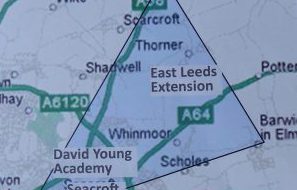“Third Wedge”, or “Northern Quadrant”?
After a week of the first named storm of winter, Storm Angus, I wondered how much we’d have to weather walking the third wedge of Leeds Pilgrimage. But against all forecasts, we walked under clear blue skies, straight into brilliant sunshine; an unexpected gift. We didn’t come prepared to need sunglasses on a winter walk in late November! Brilliant light and shadow emphasised the beauties of both the natural and the built environment.
But it was the issue of housing, and its history, which provided a linking pilgrimage theme, at this time when homelessness is such an increasing social problem in our country.
This section of the Leeds Country Way runs from Bardsey to Barwick in Elmet. The wedge which it represents, if you track lines into the city centre, includes Thorner, Whinmoor, Seacroft and Harehills. Seacroft has the distinction of being Yorkshire’s second largest council estate, built between the wars, extensively developed in the 1960s and the 1990s.
We were traversing the outer edges of estate and farm lands destined to become the “Northern Quadrant” of the East Leeds Extension, one stage of a City Council plan building 5,000 new homes on greenfield sites outside the ring road, in an arc from Wetherby Road to beyond Cross Gates.
Our walk started near the ancient Roman earthworks of Pompocali in Hetchell Woods, and ended at the Iron Age hill fort of Wendel Hill on the edge of Barwick. How have we humans inhabited the landscape and housed our population over the millennia? This was clearly an issue 2,500 years ago, and continues to provoke many questions into our communal futures.
Our pilgrimage continues on Wednesday 21 December, walking from Barwick in Elmet to Garforth and on to Swillington. To join the pilgrimage or for more information, email us at [email protected]


